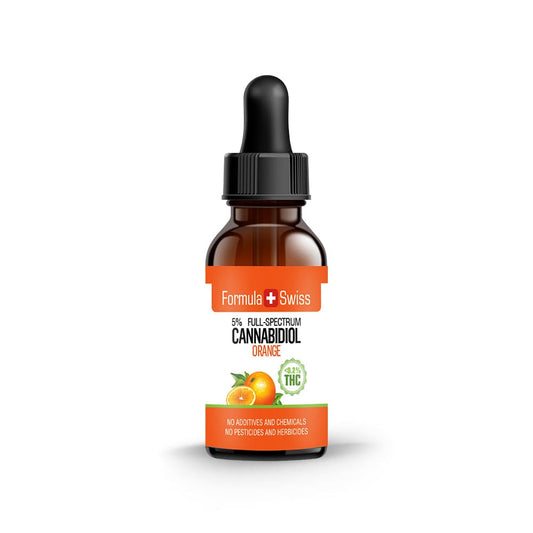Trans-nerolidol is one of those terpenes that doesn’t always get the spotlight, but it’s definitely worth paying attention to. You’ll find it in plants like jasmine, tea tree, and some cannabis varieties—and it’s known for this gentle, floral aroma with a hint of woodiness.
What’s always stood out to me is how much it adds to the overall character of a terpene-rich profile. After more than a decade working in the cannabis industry, I’ve come across a lot of plant compounds, but trans-nerolidol keeps coming up as one of the more nuanced and versatile ones.
In this article, I want to explore what makes trans-nerolidol interesting—where it shows up in nature, why it matters to people working with plants, and how it fits into the bigger picture of cannabis breeding and formulation.
Whether you’re hands-on in cultivation or just curious about what gives certain strains their unique scent, this terpene is a good one to get familiar with.
Save up to 30% when you order your CBD oil today
Key takeaways
- Trans-nerolidol is a naturally occurring terpene known for its floral, woody, and citrus-like aroma.
- It is found in a variety of plants including jasmine, tea tree, lemongrass, and certain cannabis strains.
- Trans-nerolidol contributes to the aromatic complexity of terpene-rich cannabis profiles.
- It is commonly used in fragrance, flavour, and botanical formulations across multiple industries.
- Interest in trans-nerolidol is growing due to its role in plant breeding, formulation, and terpene research.
This article is provided for informational purposes only and does not relate to any of the products available in our webshop. For more information, please see our full disclaimer.
Getting to know trans-nerolidol
Trans-nerolidol might not be a familiar name, but it’s a surprisingly versatile compound that turns up in more places than you'd think. Found in the natural scent profiles of jasmine, tea tree, lemongrass, and citrus fruits, it brings gentle floral and citrus-like notes that give many plant-based aromas their distinct character.
Chemically, it is a sesquiterpene alcohol, formally known as (±)-trans-Nerolidol. What makes it notable is its structure, which enables its use across a wide range of areas, particularly in perfumery and skincare. It offers not only a pleasant fragrance but also a functional role within these formulations.

A 2016 review published in Molecules identifies trans-nerolidol as a naturally occurring sesquiterpene alcohol involved in plant defence. It acts as a precursor to herbivore-induced volatiles such as DMNT, which help certain plants protect themselves against external pressures like insect herbivores and microbial pathogens.
This quality has led to increasing interest in how trans-nerolidol might be applied in other fields, from plant care to sustainable product development.
Although it may appear unremarkable at first, trans-nerolidol is a reminder of the depth within natural compounds. Compounds like this often carry roles beyond their immediate qualities and can inspire innovative approaches that align closely with nature.
Other sources of trans-nerolidol in nature
Trans-nerolidol is a naturally occurring sesquiterpene alcohol found in the essential oils of many plants. It contributes floral, woody and slightly citrus-like notes to the aroma of several botanicals.
Well-known natural sources include jasmine (Jasminum grandiflorum), tea tree (Melaleuca alternifolia), lemongrass (Cymbopogon citratus), ginger (Zingiber officinale), neroli (Citrus aurantium) and lavender (Lavandula angustifolia).

Within cannabis, trans-nerolidol is one of the terpenes found in certain aromatic varieties. Its presence can influence the plant’s overall scent profile and is increasingly considered in selective breeding that focuses on terpene expression.
Beyond cannabis, this terpene is widely used in perfumery and skincare, valued both for its appealing aroma and for the way it blends well with other plant-derived compounds.
Order and get up to 30% off your CBD oil
The significance of terpenes in cannabis
Understanding the chemistry of the cannabis plant helps explain many of its distinctive qualities. Terpenes play a central part in this, shaping its scent profile and influencing how the plant interacts with its environment.
A study published in Scientific Reports notes that terpenes do more than contribute to aroma — they may also interact with other plant compounds in ways that are still being investigated.
Researchers have observed that certain terpenes seem to influence how these compounds function, pointing to a layered complexity often referred to as the "entourage effect."

The diversity of terpenes across cannabis varieties is also significant. Each one has its own blend, shaping the overall profile and characteristics of the plant.
This variation makes the study of cannabis chemistry especially dynamic, as the interplay between terpenes and other compounds can vary greatly from one plant to another.
Understanding the aroma profile of trans-nerolidol
Among the many terpenes present in plants such as cannabis, trans-nerolidol is notable for its soft, inviting scent. With gentle floral and citrus undertones, this sesquiterpene contributes significantly to the fragrance profile of a range of botanicals.
Floral and citrus notes
Trans-nerolidol carries a mellow, slightly sweet aroma that combines floral tones with hints of citrus and a touch of woodiness. It occurs naturally in jasmine, lemongrass and tea tree, all valued for their aromatic qualities. Its refreshing character has made it a popular choice in perfumes and aromatherapy blends.
Comparisons with other terpenes
What sets trans-nerolidol apart is its balance. Terpenes such as myrcene or limonene often present stronger profiles — earthy-sweet in the case of myrcene, or sharply citrusy with limonene. Trans-nerolidol, by contrast, sits in between, adding depth and refinement without becoming overpowering.
Its subtle character makes it a valued ingredient in fragrance-led formulations, particularly in skincare and botanical product design, where more nuanced aromas can make a defining difference.
| Terpene | Key notes | Common occurrence |
|---|---|---|
| Trans-nerolidol | Floral, citrus, woody | Jasmine, lemongrass, tea tree |
| Myrcene | Sweet, herbal | Mango, thyme, lemongrass |
| Limonene | Citrus, strong | Orange, lemon, lime |
From what I’ve noticed, trans-nerolidol brings depth and softness to terpene blends. It’s a subtle standout—quietly elevating aromatic profiles and offering something a little different from the usual suspects.
Extraction and uses of trans-nerolidol
Trans-nerolidol is a versatile terpene with applications across a wide range of natural products. Looking at how it is sourced helps to show its importance in different industries.
Extraction methods
The method used to extract trans-nerolidol often depends on its final purpose. A traditional approach is steam distillation, which uses heat and water to gently draw the compound from plant material.
More recently, supercritical CO2 extraction has gained popularity. Although more expensive, it is widely regarded as a cleaner and more sustainable option. This technique makes it possible to capture delicate compounds like trans-nerolidol without altering their structure or quality.
Applications in industries
With its pleasant scent and versatility, trans-nerolidol is used across a range of industries. In perfumery, it adds a soft, floral freshness that pairs well with other aromatic ingredients, making it a popular choice among fragrance developers.

It also plays a role in enhancing sensory appeal within botanical and skincare products. Beyond cosmetics and personal care, trans-nerolidol is studied in agricultural contexts for its contribution to plant protection.
This wide scope of applications shows why the extraction and use of terpenes such as trans-nerolidol continue to draw attention. Whether in a fragrance composition or part of a sustainable farming practice, it has become a valued element of nature-inspired innovation.
Order CBD oil now and save as much as 30%
The role of trans-nerolidol in enhancing cannabis effects
Trans-nerolidol is a naturally occurring compound that brings a delicate floral and woody note to a plant’s aromatic profile. Beyond its fragrance, it is also being studied for its potential role in influencing how different components of the cannabis plant interact—an interaction often referred to as the “entourage effect.” This concept describes how terpenes and cannabinoids may work together to shape the overall experience.
Although scientific interest in trans-nerolidol is growing, research remains at an early stage. A study published in the journal Archives of Microbiology reported on its antioxidant and antimicrobial properties, which are currently being explored in the development of natural product formulations.
Another study in Frontiers in Neuroscience suggested that trans-nerolidol may contribute to a more grounded or calming impression when combined with cannabinoids such as THC or CBD. This is thought to occur through terpene–cannabinoid interactions, an area still under investigation.

At present, the science behind how terpenes such as trans-nerolidol influence the overall profile of cannabis-based formulations remains a developing field. While early findings are encouraging, further research, particularly involving human studies, is needed to build a clearer understanding of its potential role in botanical applications.
Trans-nerolidol cannabis strains
Among terpene-rich cannabis varieties, those with higher levels of trans-nerolidol are notable for their distinctive aroma and potential value in botanical applications. This terpene contributes floral and earthy notes that are often sought after in aroma-focused cultivation and product design.
Cultivating strains with elevated trans-nerolidol levels requires close attention to environmental factors. Conditions such as humidity, temperature and lighting all play a role in terpene expression. Careful breeding and regular testing are essential to preserve and maintain the desired terpene profiles.
Below is a selection of cannabis strains often noted for their notable levels of trans-nerolidol:
| Strain Name | Trans-Nerolidol Content |
|---|---|
| Sour Diesel | High |
| Granddaddy Purple | Moderate |
| Jack Herer | High |
| Skywalker OG | Moderate |
| Blue Dream | Low |
| Afghan Kush | High |
These strains are often chosen for their distinctive terpene composition and aromatic depth. A higher level of trans-nerolidol can contribute to a more grounding or calming profile, depending on how it interacts with other naturally occurring compounds.
Recognising the role of terpenes such as trans-nerolidol in shaping a strain’s overall character allows for more informed choices, particularly for those interested in specific aromatic or botanical qualities.

Future prospects of trans-nerolidol research
Research into trans-nerolidol is advancing, with increasing interest in its role within botanical applications and cannabis breeding. Recent studies suggest this terpene may become more influential in shaping the future of plant-based innovation.
Scientific understanding is also growing, particularly regarding how trans-nerolidol functions and interacts within complex formulations. Its potential relevance across several sectors has been noted, prompting further investigation and development.
Within cannabis breeding, efforts are focusing on optimising terpene expression and improving plant consistency. The aim is to produce varieties with more reliable levels of trans-nerolidol, supporting a wider range of applications and preferences.
| Focus area | Current insights | Future prospects |
|---|---|---|
| Pharmaceutical applications | Investigated for its role in natural compound research | Formulation of specialised products with improved delivery mechanisms |
| Cannabis breeding | Development of terpene-forward strains | Genetic refinement for stable, high-trans-nerolidol expression |
Continued innovation is paving the way for more precise applications of trans-nerolidol in both plant breeding and formulation science. As research in this field develops, its role in future botanical strategies is expected to grow in importance.

Personal perspective
Working in CBD and hemp production over the years, I’ve spent a lot of time exploring the different compounds that make each plant unique. Trans-nerolidol is one that’s always caught my attention—not just for its soft floral and woody scent, but for the way it adds depth to terpene-rich profiles.
You’ll find it in things like jasmine and tea tree oil, and in certain cannabis strains where it really helps shape the plant’s overall character.
What I’ve come to understand is that terpenes such as trans-nerolidol go beyond simply shaping aroma. As we learn more about its origins and how it interacts with other compounds, new possibilities continue to emerge in both formulation and cultivation.
From refining extraction methods to selecting traits through breeding, gaining a clearer understanding of this terpene provides another layer of insight into working with the plant in a more purposeful and considered way.
Don’t miss out—save up to 30% when you purchase CBD oil today
Frequently asked questions
What exactly is trans-nerolidol?
Trans-nerolidol is a naturally occurring terpene with a distinctive floral scent, often compared to roses. It also carries subtle citrus and woody notes. Found in plants such as jasmine, tea tree, and cannabis, it contributes to the overall fragrance profile of these botanicals.
How does trans-nerolidol contribute to the aroma of plants?
This terpene brings a delicate blend of floral and citrus tones to a plant's aromatic identity. In cannabis, it can help create a more layered and complex scent, which varies depending on the presence and interaction with other terpenes.
Can you explain the significance of terpenes in cannabis?
Terpenes play a key role in defining a plant's scent and character. In cannabis, they contribute to its aromatic complexity and may support the plant’s resilience. Their interaction with other compounds can influence the overall experience associated with a particular strain.
What methods are used to extract trans-nerolidol from plants?
Common techniques include steam distillation and solvent extraction. More advanced approaches, such as supercritical CO₂ extraction, are also used, offering improved efficiency and environmental sustainability.
How does trans-nerolidol impact the effects of cannabis?
While primarily known for its contribution to aroma, trans-nerolidol may also interact with other cannabis compounds in ways that influence the overall experience. This concept is often referred to as the entourage effect, though more research is needed to fully understand its role.
What makes high-trans-nerolidol cannabis strains unique?
Strains rich in trans-nerolidol tend to stand out for their pronounced floral and citrus aroma. This distinctive scent is one reason these varieties are often selected for sensory-focused breeding and formulation purposes.
What does the future hold for the research into trans-nerolidol?
Interest in trans-nerolidol continues to grow, both in scientific and botanical circles. As breeding techniques evolve, there is increased focus on strains with well-defined terpene profiles, including those with elevated trans-nerolidol levels.
What do experts and budtenders think about trans-nerolidol?
Many professionals in the field recognise trans-nerolidol for its aromatic appeal and potential role in differentiating strains. It is considered a noteworthy terpene when guiding plant selection or formulation strategies, with growing interest in its broader applications.






